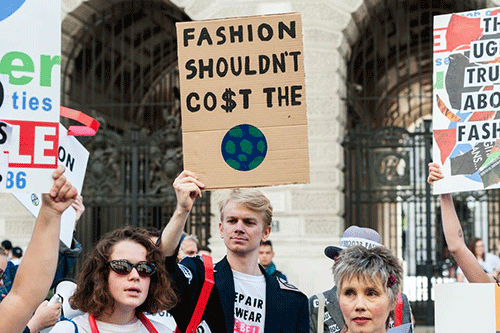 A new report by the non-profit advocacy organization Stand.Earth lists fashion as a top filthy industry and brands still “wearing last season’s greenwash” rather taking real action against polluting processes within the supply chain.
A new report by the non-profit advocacy organization Stand.Earth lists fashion as a top filthy industry and brands still “wearing last season’s greenwash” rather taking real action against polluting processes within the supply chain.
Besides accusations, the report also includes the commitments made by brands who have signed up to one of several climate change assessment/limiting initiatives, including the Sustainable Apparel Coalition, the UN Fashion Industry Charter for Climate Action and the G7 Fashion Pact. The report goes on to rank these commitments by the likelihood of achieving targets of reducing emissions needed to halt global warming to 1.5 degrees, in line with the UN Paris Agreement.
Carbon emission from brands
Initially, it assesses the commitment of brands to not only reduce their carbon emissions across the entire supply chain and operations but also their investment in renewable energies. The report declares that 8.1 per cent of global carbon emissions result from the fashion industry and this will increase nearly 60 per cent by 2030, at the current rate of growth, so renewable energy solutions are a critical imperative.
investment in renewable energies. The report declares that 8.1 per cent of global carbon emissions result from the fashion industry and this will increase nearly 60 per cent by 2030, at the current rate of growth, so renewable energy solutions are a critical imperative.
Impact on brands
In terms of relative impact, the brands on the list span Ganni, H&M, and LVMH and Kering groups. Earlier this year, the ‘Pulse of the Fashion Industry’ report (compiled by the Global Fashion Agenda, Boston Consulting Group and The Sustainable Apparel Coalition and released at the Copenhagen Fashion Summit), segmented the fashion industry by global market share. Entry price point fashion brands (e.g. Primark, H&M, and Zara) hold 43 of the global market share while mid-price brands account for 47 per cent. That leaves premium and luxury brands, including those in the LVMH and Kering stables and Ganni, at 10 per cent. Therefore, the ranking does not reveal the relative importance of the commitment of brands according to the impact they can actually have on climate change. So, if Zara, H&M, and Target, for example, managed to reduce their carbon emissions by 30 per cent it will be more than 1000 Ganni’s. The other point worth noting was the vast investment and innovation that garment manufacturers are making. The expansion of Leeds certified sustainable factories in Bangladesh, for example, has come at a huge cost to manufacturers and is entirely independent of brands.
Garment manufacturers on reduction of carbon emission
The also reveals, the largest segments of global fashion industry is actually shaped and driven by large-scale manufacturers serving the entry and mid-price point brands. And the scale at which some of these factories work dwarf the production quantities of entire brands. Pacific Jeans’ for example, has 5 garment factories in Bangladesh with 26,000 staff manufacturing 36 million garments a year for brands including Zara, H&M, Uniqlo and GAP. The climate change initiatives of a manufacturer like this far outweigh those of relatively small brands on this list, like GANT and Eileen Fisher. Soorty a vertical denim manufacturer making up to 6.5 million meters per month in their LEED platinum certified mill is an example of how pioneering sustainability initiatives can be achieved at huge scale. Ranking of the world’s largest garment manufacturers according to their initiatives to reduce carbon emissions and their use of renewable energy sources (along with the brands they manufacture for) would give far more clarity to this report.












